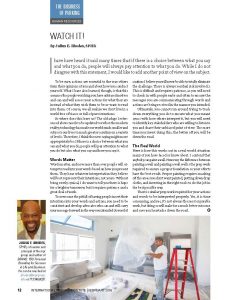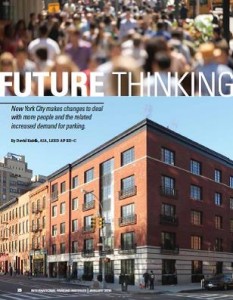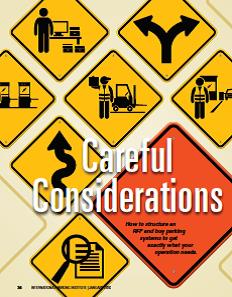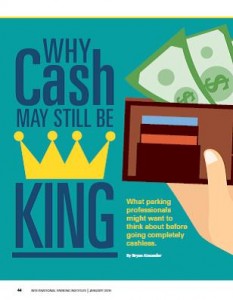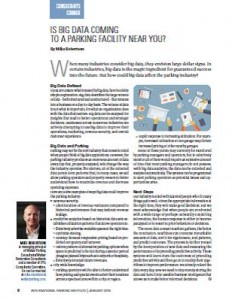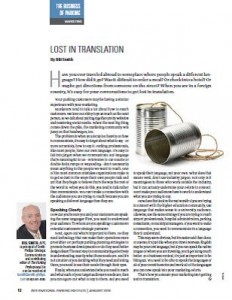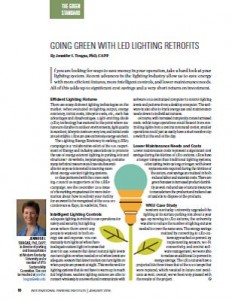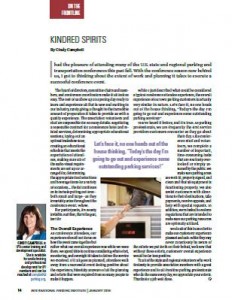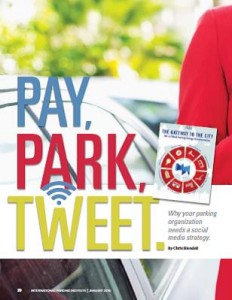 By Chris Blondell
By Chris Blondell
Like most working people, those in the parking industry have good days and bad days. You’ve probably been in a situation where you’re having a great day, everyone’s car is parked where it should be, traffic is moving in great order, and then suddenly, a man who’s visiting from out of town has had his car ticketed or towed.
And he is not happy. He yells at you. Makes assumptions. You’re now the world’s biggest idiot. He is going to make certain that you won’t have a job tomorrow.
Those moments can ruin a day. Like most parking professionals, you know it’s important to treat the man with dignity, respect, and professionalism. And you do, and you handle it, like a pro. The customer might even thank you for being so calm and understanding.
With 74 percent of adults who are online using social networking sites, this customer—and everyone like him—can now shout their frustrations/opinions/thankfulness to hundreds or thousands of other people via social media.
If you’re in the parking business, whether it be as an authority, garage, or private lot, and you’re not using social media, you’re missing out on a huge opportunity. Social media provides platforms to distribute information quickly and effectively, and it’s also an invaluable tool for customer service.
One parking organization that has demonstrated how to use social media is the Philadelphia Parking Authority (PPA). It’s one of the largest parking enforcement organizations in the country, and its five years on social media can help other parking professionals develop an idea for what can lead to success on the slippery slope of social media.
The Strength of Strategy
Realizing that there was no putting the genie back in the bottle, the PPA made the bold move to develop a social media program to achieve three objectives:
- Humanize the organization.
- Increase communication of programs and regulations.
- Provide a new channel for customer service.
Spearheaded by Director of Administration Sue Cornell and endorsed by all of its leadership, including Executive Director Vince Fenerty, the PPA worked with outside consultant ChatterBlast Media to develop a sound strategy that would carry it into the digital expanse.
“We worked very closely with all of their team to ensure we knew them inside and out,” says Matthew Ray, creative director of ChatterBlast. “This led to us developing a strategy that outlined a multi-year plan for them. Like the Boy Scouts, we were prepared.”
Once vetted, the strategy was rolled out in 2011 to loads of media attention and public interest. The strategy was a thick document that covered every possible customer complaint, crisis communication, and question that could possibly arise.
“We also addressed what our creative content would be—what we would talk about with the public: educational content, public service messages, inside information. It was very thorough, and we were confident,” says Cornell.
When starting a social media strategy, there are a few important components to consider.
First is your website
- What is its current state?
- Is it easy to navigate?
- Does it have a blog?
- How many hits does it get?
- What is the story you’re trying to tell?
- Does it need to be improved?
Your website is going to be the backbone of your social media and digital efforts. Social media efforts will drive more traffic to your website, and those new visitors will be looking for an interactive experience that is mobile friendly.
Second is your audience
- Who are they?
- What do they want?
- What are they already saying about your organization?
- What should you be saying to them?
Military strategist Sun Tzu told us to know our enemy. Hopefully, your customers aren’t hostile—get to know them before they are! Before you can provide any service—whether parking or social media interaction—you must understand your audience, especially because different demographics use social media differently.
For example, college students parking in a campus garage and long-term parking travelers in an airport lot are two totally different animals. Communicating with them via social channels will require different messages, different tactics, and possibly different platforms.
Third is your platform
You’ll want to narrow the scope and find the right platforms for your organization. The PPA and ChatterBlast launched with a blog, Facebook, and Twitter and later added YouTube.
“There was a bit of anxiety around the blog initially, but now it has become one of the website’s most go-to features,” says Ray.
How to Effectively Use a Blog
“Our goal with content is to inform and educate—to answer people’s questions before they ask them. If we tend to people’s issues or at the very least, point them in the right direction, we’re being proactive. [Social media’s] purpose is to properly inform and help citizens,” says Bill Wasser of the PPA .
After identifying the audience, the message, and the platforms, the team moved on to creating and curating content. Initially, the PPA spent a lot of time listening—and not talking—slowly creating content and taking baby steps in blog creation. There were some slight missteps and course corrections along the way.
“We can’t be funny. We tried a few times. People don’t want the PPA to be funny,” explains Ray.
But the public did want the PPA to be informative and educational. Educational content was wildly successful. Authenticity, transparency, and honesty proved to be popular, so blogs that spoke frankly about parking issues became the mainstay. Informational videos were created to share parking tips.
Everything was explained, and then explained again … and again. All of it was shared on social channels from the website.
“An informed customer is a happy customer. It’s one thing to post any relevant information on your site. It’s a whole other ballpark to post it on social media, where it will most certainly garner more traffic, more views, and more shares,” Wasser says.
“People very often don’t like surprises, especially if they’re in the form of a ticket, so any way you can avoid that will benefit your industry.”
Consistent content creation empowered the PPA to provide the public with real-time information and updates pertaining to parking in the city, events, and other relevant information. In short, integrating social media into standard business practices not only helped the PPA, but it also grew its digital voice significantly.
The blog serves as a hub for information, and the content varies in theme, topic, and medium. Popular content types for the PPA proved to be:
- Blog posts.
- Videos.
- Infographics.
“We will continue to try new ways to tell our story and to share information. We are committed to serving the public and however we need to message them, we will,” says Wasser.
Customer Service
Social media is considered by some to be the fastest and most reliable form of communication, making it fertile ground for quick and decisive customer service. Mobile communications mean customer service is happening more and more on Twitter and Facebook.
When customers have a complaint, they’re turning to social media first. If you have a public-facing organization, they are probably talking about you right now.
If someone has parking issues, it’s possible they’ll hop onto Facebook or Twitter to air their grievances. This is your opportunity as a parking professional to jump in and provide quick, responsive customer service. You’ll have an opportunity to connect with your customers as they experience problems, have questions, or simply to share feedback.
Let’s say that a customer returns to his or her car 10 minutes before the meter has expired and received a ticket. Rather than calling customer service, being put on hold, and letting their frustrations fester, he or she can simply take a photo of the ticket, post it along with a caption, and tag your organization’s page.
You, as a parking professional, can address that issue in real time and void the unnecessary ticket. Just like that, you’ve got a happy customer thanks to social media.
The plus side here is that because this is posted on an online public forum, it’ll stay up there. This means that any curious customers can peruse your page and find instances of good customer service right there online. They’ll immediately feel a stronger sense of trust that if they reach out to you on social media, they’ll receive help.
The Angry Customer
There’s always the risk that a social media user will post some “not-so-nice” comments on your page. But rather than taking it as an insult or ignoring it, view it as an opportunity to play the nice guy.
If the issue can’t be immediately resolved, a simple “We’re sorry you’ve had this experience. How can we provide a better experience next time?” post can go a long way. It’ll douse any fires and demonstrate that you care about quality experiences for your customers. It could also potentially save a relationship with an already existing customer.
After extensive research, the team developed a social media-based customer service platform to engage the community, answer questions and concerns, and escalate critical public issues to PPA directors. The strategy called for integrating enterprise-class customer service and team-based workflow technologies with existing PPA processes.
Opportunities to Shine
If you’re in a parking industry in a city or large town, there’s bound to be an event where you can help the traffic flow smoothly. It could be a 5K race that shuts down some streets for a few hours, a sporting event, or even Fourth of July festivities.
For the PPA, the opportunity to shine on social media came in October 2015 with the pope’s visit to Philadelphia (see the December 2015 issue of The Parking Professional for more).
During the visit, there were many parking concerns due to many streets throughout the city being closed for security reasons. Plenty of people needed to know if they had to relocate their cars, where they had to move them, and, if they needed to drive, where they could do so. Because of the PPA’s social media presence, concerned parkers turned to their various social media platforms in the hopes of getting answers. The results were astounding.
The PPA demonstrated leadership and established trust with the public on social media in two ways during this event:
By being present and ready on social media when it was needed. “We were one of the first city agencies to fully embrace social media and we’re proud to be a social leader in our industry. Our partnership has allowed the Philadelphia Parking Authority to build direct connections with the citizens of Philadelphia,” says Cornell. “We now handle questions, concerns, and customer service issues quickly and digitally, as well as interact with other municipal agencies and the media.”
From the pope’s visit to everyday life in Philadelphia, the PPA leverages social media for customer service. Sometimes PPA has the answer; sometimes it doesn’t. Any organization on social media will find that, but it’s still a great customer service tool. Often, just feeling like somebody is listening is enough to make a customer happy. Timely, informed responses to customer questions or complaints on social media can only help your public image and maintain your reputation as an organization that cares about its customers.
By demonstrating a unified front with other related industries. Being part of an industry that affects people’s everyday lives, you have to collaborate with other related industries. When street closures, emergencies, parades, protests, or papal visits occur, it’s imperative to amplify your message to help the entire community. The PPA did this during the pope’s visit and, as shown through the massive increase in Twitter traffic, proved to be a trusted resource for many Philadelphia visitors and residents.
“We’ve found if the public agencies collaborate in real life, it also increases the need to tag-team issues that arise on social. It’s critical to be familiar with other municipal or local initiatives so everyone involved—whether directly or tangentially—is successful,” says ChatterBlast Media Account Manager Jessica Meeder.
Your local police department will likely be very active on social media. It is an excellent example of how a government agency can use social media to its advantage and effectively engage a customer.
When big city-wide events take place, the police are sure to be informed and will probably be tweeting about it. Forming a partnership with the department’s social media team is going to help you immensely when informing citizens about the state of parking during the day.
Improve by Listening
You have to connect with the larger digital tent poles out there. Because these people are going to be blogging, posting, and tweeting about you, it’s important that you develop a relationship so that there’s no miscommunication and no misunderstanding and your message and your services are being properly communicated.
One thing you have to understand about bloggers is that they’re the voice of and for the people. For the most part, bloggers are there to represent a niche population, and if that population has a problem with your service, one complaint could easily go viral. And that’s not something you want.
Take a look at what the PPA did in this scenario. It held a “reverse press conference.” Four of Philadelphia’s top bloggers sat down with the PPA to discuss UberX. “It’s very enlightening for us to ask the press questions instead of vice versa. It allows us to get a clear-cut perspective,” Wasser says.
By the end of the reverse press conference, both parties were better informed and had a new understanding of each other. Because the PPA listened, it now has a clearer idea of what the community needs from it, and it got it from prominent folks in the blogosphere. With that, the PPA is able to develop a stronger plan and a stronger relationship with the public.
Why Your Strategy Needs Social Media
For the most part, the parking industry hasn’t embraced social media. It needs to. Parking garages, officials, and authorities need to hop on board and create a social media strategy that’s designed to:
- Humanize.
- Listen.
- Interact.
- Improve life for everyone.
Social media can be very effective to educate, inform, and interact with the public and provide great customer service. Social media is here and now, and it’s here to
stay.
Chris Blondell is content creator at ChatterBlast Media. He can be reached at chris@chatterblast.com.
TPP-2016-01-Pay, Park, Tweet

